Sunday night is movie night at this year’s Atlanta meeting. While weather-related flicks will be playing near continuously at the DVD theater this week, the 7 p.m. showing Sunday is U.S. premiere of the BBC4 program,  “Cloudspotting,” a paean to the beauties, mysteries, and wonders of the sky. Narrator Gavin Pretor-Pinney, founder of the Cloud Appreciation Society, draws on art, science, mythology, and a deep love of the sky that will undoubtedly resonate with AMS attendees and their families. We suspect there will be plenty of true cloudspotters in the audience.
“Cloudspotting,” a paean to the beauties, mysteries, and wonders of the sky. Narrator Gavin Pretor-Pinney, founder of the Cloud Appreciation Society, draws on art, science, mythology, and a deep love of the sky that will undoubtedly resonate with AMS attendees and their families. We suspect there will be plenty of true cloudspotters in the audience.
For a brief sample of the profound identification with the skies that Pretor-Pinney brings to this visually stunning 90-minute show, check out this little audio clip of him speaking at a recent author’s talk at Google, promoting his book, The Cloudspotter’s Guide.
Or follow up after the movie, when you have time, for the whole lecture:
Atlanta 2010
Take a Dip in the Wild Ocean
If you haven’t gotten your fill of science at the meeting, there’s more at the Fernbank Museum of Natural History. The museum strives to inspire life-long learning of natural history through dynamic programming and interactive science displays.
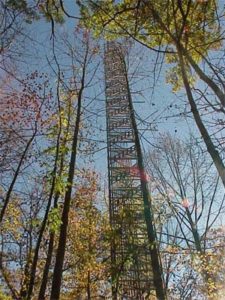
Along with their permanent exhibits, this month features a special exhibit, “My Favorite Things.” For the exhibit, each department chose a natural history piece from storage to put on display. The exhibit by nature is designed to appeal to scientists of all ages and fields in its diversity.
Of special interest to oceanographers, “Wild Ocean” is playing at the IMAX theater. Filmed on South Africa’s wild coast, the movie touches on the balance not only between the oceans and people but the relationship between all living things. Showing through March 11, show times are Monday through Saturday 11:00, 1:00, 3:00, and 5:00, with a 9:15 p.m. showing on Friday; and Sunday 1:00, 3:00, and 5:00.
We would tell you about the 7 p.m. extra showing this Friday (shhh!), but instead that’s when Richard Somerville author of the AMS-published book, The Forgiving Air, will give a talk on climate change at the museum.
Looking for Snow in Atlanta?
Northeasterners and those from colder climates visiting Atlanta may be trying to escape the snow during the Annual Meeting. But for those who aren’t, there’s a place nearby to play. Stone Mountain Park’s Snow Mountain, Atlanta’s first snow park, is a virtual winter wonderland.
The park includes a tubing hill and a 30,000 square foot play area, filled with a blizzard of snow activities. Although the manufactured snow is icy compared to the fluff that occasionally falls in Atlanta, the warmer air temperatures allow for more comfortable outdoor play.
Originally planned to open in 2007, the park was widely criticized for its plans to use one million gallons of tap water during a drought. The plan was changed to use water from the park’s own lake and the park opened last year.
December East Coast Snowstorm a Cat. 3
Memories of the pre-Christmas snowstorm that paralyzed travel across megalopolis in mid December might not be as fresh as the severe cold snap that kicked off the new year east of the Rockies. But the storm, which dumped 1-2 feet of snow on the Mid-Atlantic, earned a Category 3 ranking on the Northeast Snowstorm Impact Scale, known as NESIS, classifying it as a “major” winter storm.
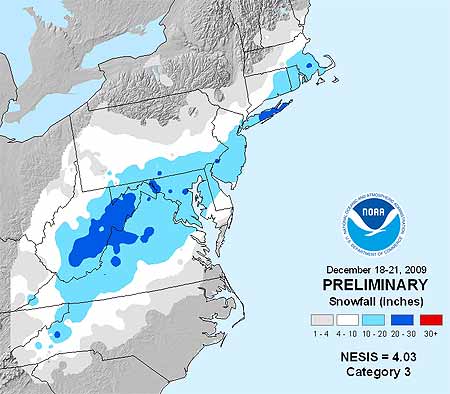
NOAA’s NESIS ranks Northeast snowstorms on a five-tier scale ranging from Category 1 “Notable” to Category 5 “Extreme.” It characterizes the storms based on how much snow falls (must deposit at least 10 inches); the size of the area affected, and the population of the impacted area. Developed in 2004 by renowned winter weather experts Louis Uccelini and Paul Kocin, both with the National Centers for Environmental Prediction, catalogs snowstorms dating back to 1888.
“Last month’s storm was one of only five in the past decade that ranked Category 3 or higher,” says Kocin. The others: December, 2002 (Category 3); February, 2003 (Category 4); January, 2005 (Category 4); February, 2006 (Category 3), and February, 2007 (Category 3). Topping the NESIS scale—and the only winter storms rated Category 5—are the “Superstorm” on March, 1993 and the “Blizzard of ’96” in January, 1996. Last month’s snowstorm fell short of the higher NESIS rankings for several reasons, explains Uccelini.
“While snowfall from the December storm ranked in the top ten for Washington, Baltimore and Philadelphia, the storm only provided a glancing blow to the New York City and Boston metropolitan areas and overall affected a relatively small area. This led to it being classified as a Category 3,” he says.
Although NESIS is the only snowfall index being used operationally by NOAA, there are NESIS-like indices being developed for other parts of the nation. At the AMS Annual Meeting in Atlanta, a presentation by Michael F. Squires (Wednesday, 20 January, 2:00 PM, B211) will discuss the Development of regional snowfall indices.
Addtionally, David Robinson of Rutgers University will introduce a new climate data record of satellite-derived snow cover extent in his presentation Northern Hemisphere snow cover extent during the satellite era (Wednesday, 20 January, 10:30 AM, B218).
Georgia’s Got a Groundhog, Too
He may not be Punxsutawney Phil, but General Beau Lee is the groundhog to look to for the winter forecast in Georgia. Although he doesn’t make his official appearance until February, Beau’s home, the “Weathering Heights” mansion at Yellow River Game Ranch (www.yellowrivergameranch.com), is a good getaway destination this week if you’re looking for meteorological curiosities or trying to entertain the family.
Located just two and one-half miles east of Stone Mountain on Highway 78, the ranch offers an opportunity not only to meet furry weathercasters, but other animals on an up close and personal basis. Walk down a mile-long trail on 24 wooded acres, where over six hundred birds and animals indigenous to the state of Georgia reside.
Located on the banks of the Yellow River, the ranch was affected by the heavy rains and floods in September, but fortunately no animals, nor the mansion, were in danger and the ranch is back to functioning as usual.
The Yellow River Game Ranch is open from 10:00 to 5:00 Monday through Friday and 10:00 to 6:00 Saturday and Sunday. For more details visit the Web site.
The Ballots Are In…Now Meet the Winners
With the New Year comes the season for annual awards and “Best of” lists of every kind, from Oscars to best beer to best iPhone apps. But how often do you actually get invited to the awards ceremony? Here in Atlanta you can practically walk the red carpet with the winners.
On Wednesday at 4:45 p.m. (Publisher’s Row, Exhibit Hall), Atmospheric Science Librarians International (ASLI) will be presenting its fifth annual ASLI Choice awards for the Best Books of 2009.
This year’s winner in the “science” category is Clouds in the Perturbed Climate System: Their Relationship to Energy Balance, Atmospheric Dynamics, and Precipitation, edited by Jost Heintzenberg and Robert J. Charlson. According to ASLI, it was selected for its “quality, authoritativeness, and comprehensive coverage of new and important aspects of cloud research.” 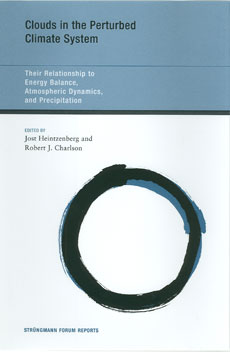
A new category for “popular” books was added to this year’s awards, and the winner is this class is Planet Ice: A Climate for Change, with photography by James Martin and essays by Yvon Chouinard. It was chosen for “beautiful photography accompanied by thoughtful essays on a topical and timely subject.”
Runners-up in the “science” category are Aerosol Pollution Impact on Precipitation : A Scientific Review, edited by Zev Levin and William R. Cotton, for an “authoritative, well organized, forum-based approach to the evaluation of a problem of global significance”; Hydroclimatology: Perspectives and Applications, by Marlyn L. Shelton, for a “well-considered, well-referenced text on an important topic”; and Climate Change and Biodiversity: Implications for Monitoring Science and Adaptive Planning, by D. C. MacIver, M. B. Karsh and N. Comer, for “good, clear authoritative statistical compilations, graphics, and charts on a important subject.”
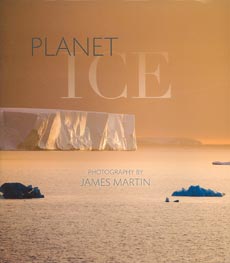
And if we may blow our own horn for a moment, the runner-up in the “popular” category is Jack Williams’s AMS Weather Book: The Ultimate Guide to America’s Weather, with ASLI noting “its accessible and informative approach to all aspects of weather, and the richness of its illustrations.”
Publisher’s Row will also be the place to find the AMS books booth as well as some of the other leading publishers of atmospheric science books. In fact, along with the AMS Weather Book, two of the other ASLI’s Choice winners are published by companies that will be displaying their titles at the meeting: Aerosol Pollution Impact on Precipitation (published by Springer) and Hydroclimatology (published by Cambridge University Press).
Congratulations to all the winners!
A Minimum of Maximum Concern
There are a lot of questions about the current solar minimum, which has reached historic levels—“No solar physicist alive today has experienced a minimum this deep or this long,’’ according to NASA’s Madhulika Guhathakurta, lead program scientist for NASA’s Living With A Star program, which studies solar variability and its effects on Earth. Some of the effects of the minimum are fairly clear to scientists: the amount of cosmic rays entering our portion of the solar system is greater than normal, and Earth’s ionosphere has shrunk.
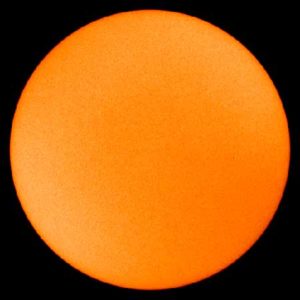
The debate is instead partly about the effect of the minimum on Earth’s climate. A recent study by Judith Lean of the Naval Research Lab and David Rind of NASA’s Goddard Institute for Space Studies suggests that decreased solar irradiance during the current minimum cycle may be slightly offsetting recent warming attributed to greenhouse gases. Even if the minimum is affecting climate, it may be of minimal consequence.
“. . . [O]nly about 10 percent of climate variation is due to the sun,” notes Leon Golub, senior astrophysicist at the Harvard-Smithsonian Institute for Astrophysics. “That means 90 percent isn’t.”
Just as importantly, the solar minimum won’t last forever, so any climatic effects are temporary, as well. But when will solar activity turn around? The current minimum began in 2000 and has been particularly deep for the last two years. At the AMS Annual Meeting, Joseph Kunches of NOAA’s Space Weather Prediction Center attempts to pinpoint the arrival of the next solar maximum and ponders its potential effects in his presentation, “Solar Cycle Update—Will the New Cycle Please Start?” (Monday, 2:15–2:30 p.m., B303). And Matthew J. Niznik and W. F. Denig of the National Environmental Satellite, Data, and Information Service introduce a new indicator, the Genesis Minimum Quiet Day Index, which analyzes sunspot activity and suggests that the current solar minimum is not anomalous. Their index and the larger topic of the influence of solar activity on Earth’s climate are explored in their poster, “Impacts of Extended Periods of Low Solar Activity on Climate” (Monday, 2:30–4:00 p.m., exhibit hall B2).
Innovations in Climate Adaptation
UPDATE, 1/17/10: Due to a last-minute scheduling change, Amanda Lynch will be unable to attend the Annual Meeting. Adaptive Governance and Climate Change will still be a featured release at the AMS Book Launch Party on Monday.
The recent Copenhagen conference provided yet more evidence that countries with completely different priorities are often reluctant to enter into complex and costly agreements with each other. While international negotiations may seem cumbersome at best, some scholars argue that climate change may best be solved at the local–rather than international–level. Local action may not only be more effective but also could also someday might lead to international agreements.
This local-first policy approach will be explored in a variety of ways at the AMS Annual Meeting, headlined by the release of a new AMS book, Adaptive Governance and Climate Change, by Ronald Brunner and Amanda Lynch. Brunner and Lynch show how locally based programs foster the necessary diversity and innovation for climate adaptation. 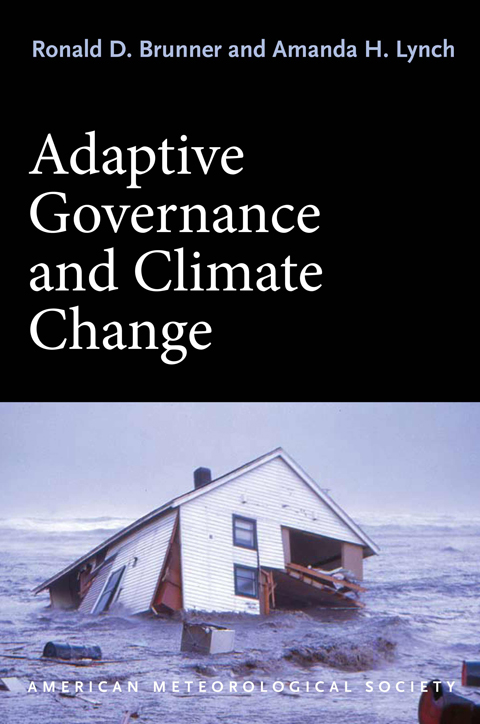 Their book focuses on the real-life climate issues faced by Barrow, Alaska—and analyzes how the policies developed to address those issues could be adopted by other communities.
Their book focuses on the real-life climate issues faced by Barrow, Alaska—and analyzes how the policies developed to address those issues could be adopted by other communities.
In Atlanta, Lynch will be available to discuss these policy perspectives when the book is released as part of the AMS Book Launch Party (Monday, 5:30 p.m., exhibit hall B1, booth 146). In addition, she will be signing copies of the book on Monday and Wednesday (2:45–4:00 p.m., exhibit hall B2).
Communities across the world are moving toward adaptive governance, as can be seen in a number of presentations at the Annual Meeting. Nanteza Jamiat’s poster on “Adaptation Challenges to Climate Change Disasters in the Karamoja Cluster (Cattle Corridor) in Uganda” (at the student poster session, Sunday, 5:30–7:00 p.m., exhibit hall B2) addresses the interrelationship of climate change and agriculture in a country where both are a way of life for most of the population. Barry Smit’s presentation on “Traditional Knowledge and Adaptation to Climate Change in the Canadian Arctic” (Wednesday, 9:00–9:15 a.m, B213) focuses on indigenous people in the Arctic and the cultural barriers that sometimes need to be broken in order to implement local adaptation initiatives. The Pacific Island nation of Tuvalu is the subject of “Weathering the Waves: Climate Change, Politics, and Vulnerability in Tuvalu,” a poster by Heather Lazrus (Monday, 2:30–4:00 p.m., exhibit hall B2) that shows how one of the most vulnerable areas in the world is in some cases reverting to traditional governmental methods to meet the perils of climate change. And Cynthia Fowler’s presentation on “Coping in Kodi: Local Knowledge about and Responses to Climate Change and Variable Weather on Sumba (Eastern Indonesia)” (Tuesday, 4:15-4:30 p.m., B213) notes that many people in Indonesia’s marginal environments relate climate change to local development, thus crystallizing in one small area many of the problems that were evident at Copenhagen between developing and developed countries.
NWS Increases Severe Hail Threshold
If you step outside in a thunderstorm and get bonked on the head with penny size hail, don’t blame your misfortune on a severe storm. On January 5, the National Weather Service changed the criteria for severe thunderstorms by upping the minimum size hail from ¾ to 1 inch—quarter size. The wind threshold—50 knots, or 58 mph—remains the same.

The reason for the change, according to a statement issued by the Fire and Public Weather Services Branch of the NWS, is that research reveals “significant damage” doesn’t occur from hail smaller than an inch. Hailstones the size of quarters or larger are the ones most destructive to cars, homes, buildings, and crops.
Over the years, and particularly in the Plains states, the statement reads, “the frequency of severe thunderstorm warnings issued for penny-size and nickel-size hail might have desensitized the public to take protective action during a severe thunderstorm warning.” Too many warnings for events that were not damaging garnered complaints and made the warnings somewhat meaningless.
Experimental warnings for 1-inch hail in Kansas the last few years expanded in the central and western United States in 2009. Emergency managers and media outlets in the areas that previously made the changes noted that people seem to take warnings for severe hail more seriously now as they carry more weight.
Of course observing hailstones 1 inch or larger and forecasting hail size are two different things. But, just as research has supported increasing the severe hail threshold, scientists are making strides toward more accurately predicting hail size from radar observations of severe thunderstorms. A poster that will be presented by Matthew Kramar of the NWS office in the Washington, D.C. area, et al., on Wednesday afternoon at the Annual Meeting (January 20, 2:30-4:00 PM, Exhibit Hall B2) reveals results of correlating radar hail cores to hail size for the Mid-Atlantic region—a study that piggybacks on successes in establishing operational hail prediction in the Plains states.
Shedding New Light on Night-Shining Clouds
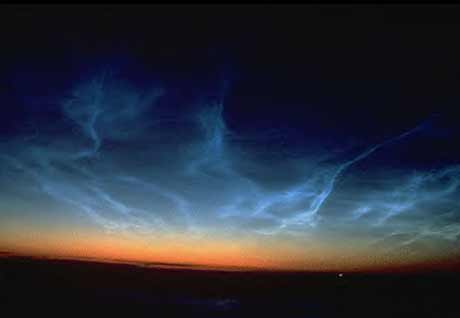
Scientists have been making new progress in solving the mysteries of noctilucent clouds [also known as Polar Mesospheric Clouds (PMCs)], thanks to NASA’s Aeronomy of Ice in the Mesosphere (AIM) satellite. AIM recently recorded a series of complete polar seasons of these clouds, which form in the mesosphere and are only visible on Earth when illuminated by sunlight from below the horizon. The satellite’s findings “have altered our previous understanding of why PMCs form and vary,” according AIM principal investigator James Russell III of Hampton University in Virginia.
AIM observed the PMCs in each hemisphere’s summer season at all longitudes and over a latitude range of 60°–85°; this video shows the clouds in the northern skies from late May to mid-August of 2009.
AIM’s data revealed that the clouds form and dissipate at very high speeds and may be affected by high-altitude weather systems.
“The cloud season abruptly turns on and off going from no clouds to near complete coverage in a matter of days, with the reverse pattern occurring at the season end,” Russell said. Russell likens this seasonal on-off switch to a “geophysical light bulb” in the presentation he will make about the new findings at the Space Weather Symposium during the AMS Annual Meeting in Atlanta (Tuesday, 8:30 AM, B303).
Noctilucent clouds are made of ice crystals that form when water vapor condenses onto dust particles at extremely cold temperatures (around -210° to -235°F). Scientists are using the new imagery as well as computer models to figure out more about what conditions trigger the clouds. So far, the new data indicate that high altitude temperature determines the onset, variability, and end of the cloud season. Satellite imagery also seems to show relationships to planetary waves as well as smaller scale gravity waves in the atmosphere.